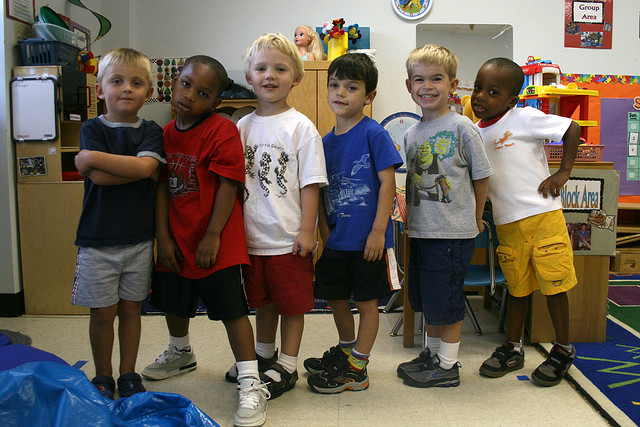Speech is a wonderfully complex skill, and children need lots of practice to learn how to do it. As with any motor skill, children make plenty of mistakes as they learn to speak clearly.
In English, we hear several common patterns of error in children’s speech as they grow up. Here are 10 common types of error pattern, and the approximate age by which we expect them to be ‘fixed’ (gone) in typically developing children:
1. Assimilation:
Lala wants the lellow kuk. (Lara wants the yellow truck.)
It’s human nature to do as little work as possible, and our tongues, lips and other ‘articulators’ can be just as lazy as the rest of us! Often one sound in a word will affect one or more other sounds in the word. This is called assimilation (or consonant harmony). Sometimes, the first sound in a word will change later sounds, e.g. if the child said ‘beb’ for ‘bed’. This is called progressive assimilation. Other times, later sounds in a word affect earlier sounds, e.g. if a child says ‘lellow’ for ‘yellow’. This is called regressive assimilation.
When to consider seeking help: if assimilation is still a feature of your child’s speech at the age of 2½-3 years of age.
2. Reduplication:
The taitai needs wawa. (The tiger needs water.)
When children repeat a syllable twice, rather than pronouncing both syllables of the word, they can sound a bit like babies babbling (e.g. mama, dada). When we hear it in 3-5 year olds, we call this error pattern reduplication. It almost always happens when the child repeats the stressed syllable twice, at the expense of the weak syllable, e.g. as in tiger and water above.
When to consider seeking help: if your child is 2½-3 years old or older and reduplicating syllables more than occasionally.
3. Voicing:
I fount a pek for the bram. (I found a peg for the pram.)
The sentence above makes no sense whatsoever. But it allows me to illustrate voicing errors. In English, we produce some of our sounds with our vocal cords apart. These are called unvoiced sounds, which include sounds like p, t, k, s and sh. For other sounds, we bring our vocal cords together to ‘turn on’ our voices. These are called voiced sounds and include b, d, g, z and n. It takes a lot of control to turn your voice on and off during speech, and it’s not unusual for some children to make errors like not voicing sounds when they should (e.g. pek instead of peg) or voicing sounds when they shouldn’t (e.g. bram instead of pram).
Age at which you should you consider therapy: 3 years (or younger if your child is being teased for it).
4. Final consonant deletion:
Gi me my du ma ba. (Give me my duck mat back.)
Young children often omit the final consonants in their words. This is called (appropriately enough) final consonant deletion. It can have a big impact on how easy your child is for others to understand – could you understand the example sentence above without the translation?
When to consider seeking help: if your child is regularly omitting final consonants in words at the age of 3 years, 3 months.
5. Fronting:
Sorn tan’t find any eds to teep. (Sean can’t find any eggs to keep.)
This type of error is called fronting. It occurs when sounds normally produced with the tongue positioned at the back of the mouth (e.g. k, g and sh) are instead produced with the tongue positioned towards the front of the mouth (e.g. like t, d, and s).
Age at which you should you consider therapy: 3½-4 years of age (or younger if your child is hard for others to understand or being teased for it).
6. Stopping:
Da ban crac into dit debra. (The van crashed into this zebra.)
This ghoulish sentence illustrates stopping. In English, many speech sounds can be stretched out and held continuously until you run out of breath. Sounds like s, z, f, v and th, are good examples. Other speech sounds can’t be held continuously, e.g. p, b, t, d, k and g, which are all examples of ‘plosives’. It’s common for young children to substitute plosives for continuous sounds. We call this ‘stopping’ because the children are ‘stopping’ the sounds, e.g. turning the ‘this’ with its nice continuous ‘th’ and ‘s’ sound into ‘dit’.
Age at which you should you consider therapy:
- 3 years of age for ‘f’ or ‘s’ (or younger if your child is being teased for it);
- 3½ years of age for ‘v’ or ‘z’ (or younger if your child is being teased for it);
- 4½ years of age for ‘sh’, ‘j’ or ‘ch’ (or younger if your child is being teased for it); and
- 5-7 years of age for ‘th’ (as in ‘thin’) and ‘th’ (as in ‘the’) (or younger if your child is being teased for it).
7. Weak syllable deletion:
The efant needs a brela. (The elephant needs an umbrella.)
When we speak, we don’t emphasise each of our syllables equally. For example, in the word ‘telephone’, we usually place the stress on the ‘te’ and ‘phone’, leaving the ‘le’ syllable in the middle un-stressed and weak. In ‘umbrella’, we stress the ‘bre’, leaving the ‘um’ unstressed and weak. I’ll spare you a lecture about Trochaic and Iambic stress patterns in English. Why I mention stress patterns is that it’s common for young children to omit weak syllables. We call this weak syllable deletion.
Age at which you should you consider therapy: 4 years (or younger if your child is being teased for it).
8. Cluster Reduction:
There’s a ‘cary ‘pider in my room! (There’s a scary spider in my room!)
Many words in English contain combinations or ‘clusters’ of consonants, e.g. squawk, crab or flower. It’s common for young children to omit one or more of the consonants in a cluster (so called cluster reduction), and there are some clever rules of thumb speech pathologists use to help us predict which ones.
Age at which you should you consider therapy: 4-5 years (or younger if your child is hard for others to understand or is being teased for it).
9. Deaffrication:
“Zhack broke my wash”. (‘Jack broke my watch.’)
This one has a fancy name – deaffrication – and needs some explanation.
The word “affricate” comes to us via German from the same Latin root as friction, meaning ‘rub together’. In English, we have two affricate speech sounds – ‘ch’ (as in “chat”) and ‘j’ (as in “Jack”). Each is made by “rubbing together” two speech sounds:
- the “ch” sound in “check” – transcribed as /tʃ/ in the International Phonetic Alphabet or IPA – is a combination of /t/ (as in “tell”) and “sh” (/ʃ/), as in “shell”; and
- the “j” sound – transcribed as /dʒ/ in IPA – is a combination of /d/ (as in “dog”) and “zh” (/ʒ/ in IPA), as in the middle of “vision”.
Deaffrication occurs when an affricate is simplified by leaving out the first speech sound of the pair, e.g., when:
- “chain” (/tʃein/) is pronounced as “Shane” (/ʃein/);
- “watch” /wɒtʃ/ is pronounced as “wash” (/wɒʃ/);
- “Jack” (/dʒaek/) is pronounced as “Zhack” (/ʒaek/); or
- “hedge (/hɛdʒ/) is pronounced as “hezh” (/hɛʒ/).
Age at which you should you consider therapy: 5 years of age (or younger if your child is being teased for it).
10. Gliding:
The wabbit woves wed wibbons. (The rabbit loves red ribbons.)
We call this error pattern gliding. It’s most common with r and l. Two year olds who glide are often praised for their cuteness. Gliding is not so adorable when you’re seven.
Age at which you should you consider therapy: 5-6 years of age (or younger if your child is being teased for it).
Other considerations
In reality, young children – especially 2 and 3 year olds – often make many of these errors in the same sentence, e.g. ‘dec a tary fwigt’n pider in my woo’. This can make it very difficult for adults who don’t know a child well to understand what he or she is trying to communicate.
The above suggested ages for considering seeking help are, of course, only guides. You are the expert on your child and you should always feel free to discuss your child’s speech development with a speech pathologist.
As a general rule, if:
- your child’s speech is noticeably less developed or easy to understand than that of his or her peers;
- your child shows signs of anxiety or frustration about his or her speech;
- your child is self-conscious about his or her speech, or is being teased or bullied;
- your child’s childcare, pre-school or school teachers flag concerns about your child’s speech;
- you simply want to check that there’s nothing to worry about; or
- your child’s speech features any of these error patterns at 5 years of age,
we recommend you contact a speech pathologist to discuss your concerns.
Principal sources: Dodd, Hua, Crosbie, Holm & Ozanne (2002); Grunwell (1987); McLeod (1996); Bowen (1998).
Related articles:
- Lifting the lid on speech therapy: how we assess and treat children with unclear speech – and why
- My child’s speech is unclear to adults she doesn’t know. Is that normal for her age? (An important research update about child speech intelligibility norms)
- 12 speech-related warning signs that your child might have a hearing problem
- Important update: In what order and at what age should my child learn to say his/her consonants? FAQs
- Speech sound disorders in children
- How to treat speech sound disorders 1: the Cycles Approach
- How to treat speech sound disorders 2: the Complexity Approach
- How to treat speech sound disorders 3: Contrastive Approach – Minimal and Maximal Pairs
- How to identify and treat young children with both speech and language disorders
- ‘He was such a good baby. Never made a sound!’ Late babbling as a red flag for potential speech-language delays
- Why preschoolers with unclear speech are at risk of later reading problems: red flags to seek help
Image: http://tinyurl.com/neoc5by

Hi there, I’m David Kinnane.
Principal Speech Pathologist, Banter Speech & Language
Our talented team of certified practising speech pathologists provide unhurried, personalised and evidence-based speech pathology care to children and adults in the Inner West of Sydney and beyond, both in our clinic and via telehealth.


Leave a Reply